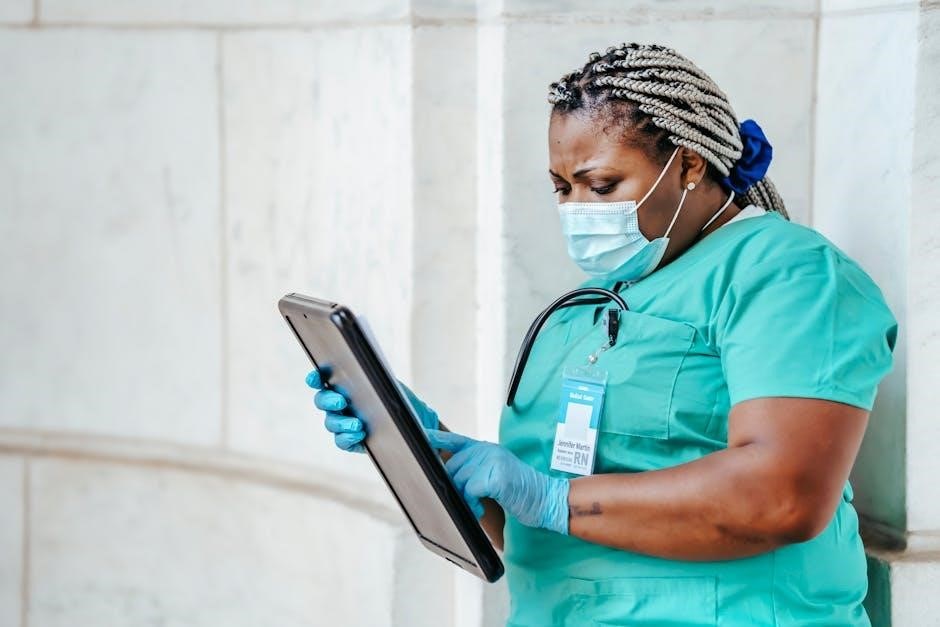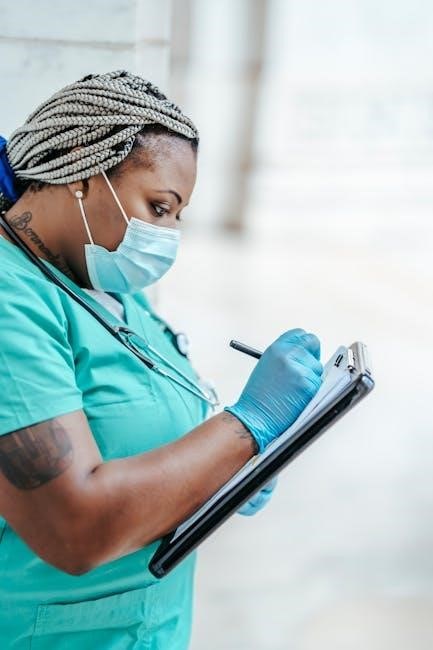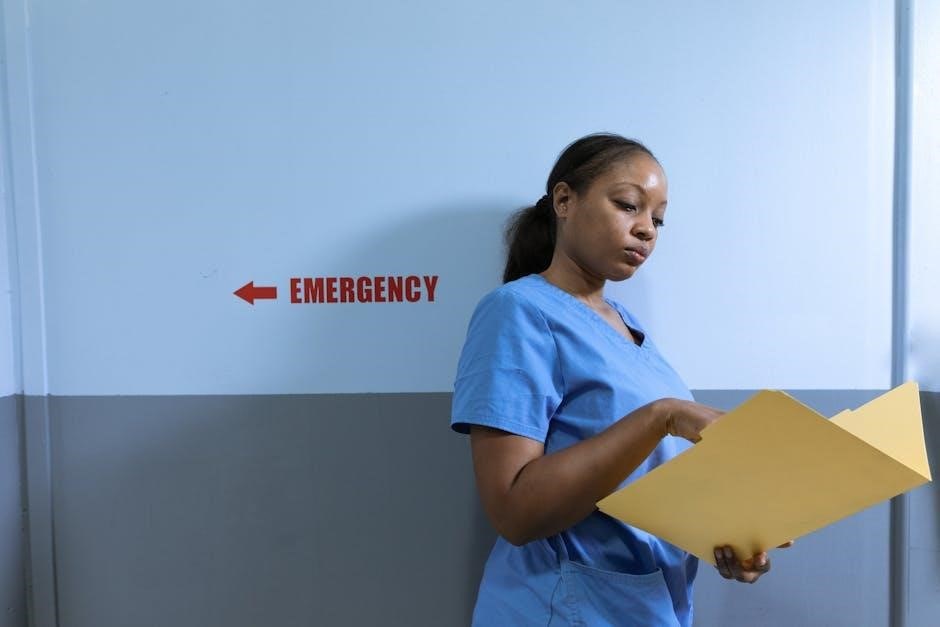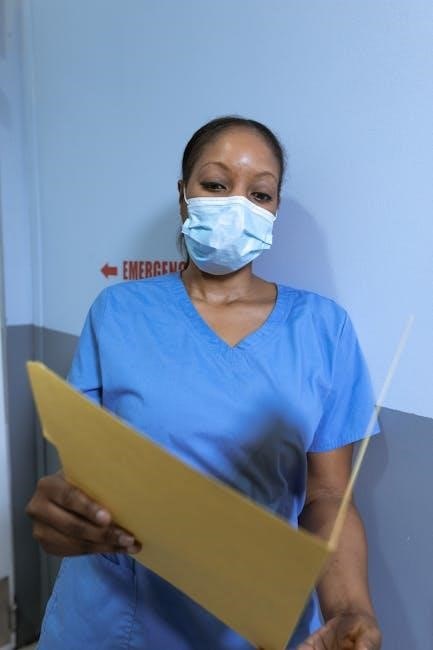Nursing documentation is a comprehensive and legal record of patient care‚ ensuring clear communication‚ accountability‚ and continuity of care. It reflects the nursing process and patient outcomes accurately.
1.1 Definition and Overview
Nursing documentation is the systematic recording of patient care‚ including assessments‚ interventions‚ and outcomes. It serves as a legal and professional record‚ ensuring accountability and effective communication among healthcare providers.

1.2 Importance of Nursing Documentation
Nursing documentation is vital for ensuring continuity of care‚ improving patient outcomes‚ and providing legal protection. It serves as a communication tool among healthcare providers‚ promoting accountability and transparency. Accurate documentation reflects the quality of care‚ supports evidence-based practice‚ and helps in evaluating the effectiveness of interventions. It also protects nurses legally by providing a clear record of their actions and decisions. Effective documentation is essential for maintaining professional standards and delivering safe‚ patient-centered care.

The Nursing Process and Documentation
The nursing process integrates assessment‚ diagnosis‚ planning‚ implementation‚ and evaluation‚ with documentation ensuring continuity of care‚ accountability‚ and accurate records of patient interactions and outcomes.
2.1 Assessment
Assessment is the initial phase of the nursing process‚ involving the collection of comprehensive data about a patient’s physical‚ emotional‚ and social health. This step lays the foundation for identifying patient needs and developing individualized care plans. Nurses gather information through observations‚ interviews‚ physical examinations‚ and diagnostic tests. Accurate and thorough documentation of assessment findings ensures continuity of care and informs the healthcare team. It reflects the patient’s health status‚ facilitating effective communication and the subsequent phases of the nursing process.
2.2 Diagnosis
Diagnosis in nursing involves identifying patient problems‚ risks‚ or health conditions based on assessment data. Nurses formulate nursing diagnoses that guide care planning and interventions. Accurate documentation of diagnoses ensures clarity and consistency in care delivery. It reflects the patient’s specific needs and serves as a legal record of the nurse’s professional judgment. Effective documentation of diagnoses also facilitates communication among healthcare providers‚ promoting coordinated and patient-centered care. This step is crucial for developing targeted interventions and achieving desired patient outcomes.
2.3 Planning
Planning involves creating individualized care plans based on patient needs and diagnoses. Nurses outline specific‚ measurable goals and interventions to address health issues. Documentation during planning ensures clarity and continuity of care. It reflects the patient’s priorities and expected outcomes‚ serving as a roadmap for interventions; Accurate and detailed planning documentation promotes accountability and effective communication among healthcare providers. This step ensures that care is patient-centered‚ evidence-based‚ and aligned with professional standards‚ ultimately enhancing patient outcomes and legal compliance.
2.4 Implementation
Implementation is the execution phase where nurses deliver planned interventions and document the care provided. This includes administering medications‚ conducting treatments‚ and educating patients. Documentation during implementation records the specific actions taken‚ patient responses‚ and any modifications to the care plan. Accurate and timely documentation ensures continuity of care‚ communicates patient progress‚ and maintains accountability. It also serves as a legal record of the care provided‚ reflecting adherence to the established plan and professional standards.
2.5 Evaluation
Evaluation involves assessing patient outcomes and the effectiveness of nursing interventions. Nurses document patient responses‚ progress toward goals‚ and any changes in condition. This phase ensures care is adjusted based on patient needs and outcomes. Documentation during evaluation reflects accountability‚ providing a clear record of care effectiveness. It also informs future planning and communication among healthcare teams‚ ensuring continuity and adherence to professional standards. Accurate evaluation documentation is critical for legal and professional accountability in nursing practice.
Legal and Ethical Considerations
Nursing documentation is governed by legal and ethical standards‚ ensuring patient confidentiality‚ data accuracy‚ and accountability. It reflects adherence to professional codes and organizational policies‚ safeguarding trust and compliance.
3.1 HIPAA Compliance
HIPAA compliance is a critical legal requirement in nursing documentation‚ ensuring the confidentiality‚ integrity‚ and availability of protected health information (PHI). Nurses must adhere to strict guidelines when handling patient data‚ including secure storage‚ limited access‚ and encrypted transmission. Breaches can result in severe penalties‚ emphasizing the importance of training and adherence to protocols. Accurate and timely documentation helps maintain patient trust and avoids legal repercussions‚ aligning with professional standards and organizational policies for safeguarding sensitive information. Proper HIPAA practices are essential in all healthcare settings.
3.2 Confidentiality and Patient Privacy
Confidentiality and patient privacy are fundamental ethical obligations in nursing practice‚ ensuring that sensitive patient information remains protected. Nurses must uphold these principles by securely handling medical records and sharing information only with authorized personnel. Breaches of confidentiality can erode patient trust and lead to legal consequences. Adhering to ethical standards and organizational policies ensures that patient privacy is maintained throughout the documentation process‚ fostering a safe and respectful care environment. Accurate and secure documentation practices are essential to preserving patient confidentiality.
3.3 Accountability in Nursing Practice
Accountability in nursing practice ensures that nurses are responsible for their actions and decisions‚ with documentation serving as a legal and professional record of care provided. Accurate and thorough documentation protects both patients and nurses‚ demonstrating adherence to standards of care. It reflects the nurse’s commitment to ethical practice and patient safety‚ while also providing evidence of competency and professionalism. Proper documentation fosters transparency and trust‚ making nurses accountable for their interventions and outcomes in patient care.
Methods and Formats of Nursing Documentation
Nursing documentation uses standardized formats like narrative notes‚ SOAP notes‚ and care plans to organize patient information effectively‚ ensuring clarity and accessibility for healthcare teams.
4.1 Narrative Notes
Narrative notes are a traditional method of documenting patient care‚ capturing events chronologically. They provide a detailed‚ subjective account of patient interactions‚ observations‚ and care provided. This format allows nurses to describe patient progress‚ concerns‚ and interventions in a storytelling manner. Narrative notes are often used for complex or unusual cases‚ offering flexibility in documentation. However‚ they can be less structured compared to other methods‚ requiring clear and concise writing to ensure accuracy and readability. They remain a valuable tool for maintaining comprehensive patient records.
4.2 SOAP Notes
SOAP notes are a standardized method of documentation‚ organized into four sections: Subjective‚ Objective‚ Assessment‚ and Plan. Subjective includes patient-reported information‚ while Objective contains measurable data like vital signs. Assessment involves the nurse’s interpretation of the findings‚ and Plan outlines the next steps in care. SOAP notes promote clarity‚ organization‚ and consistency‚ making them a widely used format in healthcare. They enhance communication among providers‚ support legal documentation‚ and facilitate continuity of care‚ ensuring a structured approach to patient management and intervention.
4.3 Care Plans
Care plans are detailed‚ individualized documents outlining a patient’s specific needs‚ goals‚ and interventions. They guide nursing actions‚ ensuring coordinated and targeted care. Components include assessment data‚ diagnoses‚ outcomes‚ and evaluation criteria. Care plans promote evidence-based practice‚ improve patient outcomes‚ and enhance accountability. They are regularly updated to reflect progress and changing patient needs‚ serving as a communication tool among healthcare providers. Effective care plans ensure continuity of care and align interventions with patient-centered goals‚ fostering a collaborative approach to healthcare delivery.

Benefits of Effective Nursing Documentation
Effective nursing documentation ensures continuity of care‚ improves patient safety‚ and provides legal protection. It enhances communication‚ accountability‚ and transparency‚ supporting better patient outcomes and professional accountability.
5.1 Continuity of Care
Effective nursing documentation ensures continuity of care by providing a clear‚ chronological record of patient interactions and treatment plans. This allows healthcare teams to track progress‚ identify patterns‚ and make informed decisions. Accurate documentation bridges gaps between shifts‚ departments‚ and care settings‚ fostering seamless collaboration. Timely updates enable consistent care delivery‚ reducing errors and improving patient safety. By maintaining detailed records‚ nurses ensure that all team members are aligned‚ promoting coordinated and holistic patient management. This enhances overall patient outcomes and satisfaction.
5.2 Improved Patient Outcomes
Accurate and thorough nursing documentation directly contributes to improved patient outcomes by ensuring evidence-based care. Clear records allow healthcare providers to evaluate the effectiveness of interventions and make timely adjustments. Documenting patient responses to treatments enables personalized care‚ preventing complications and enhancing recovery. Comprehensive records also facilitate early identification of trends‚ promoting proactive interventions. By maintaining detailed and precise documentation‚ nurses play a pivotal role in delivering high-quality‚ patient-centered care that optimizes health outcomes and reduces risks. This underscores the critical link between documentation and positive patient results.
5.3 Legal Protection
Effective nursing documentation provides legal protection for nurses and healthcare institutions. Accurate and detailed records serve as evidence of the care provided‚ demonstrating adherence to standards and reducing liability risks. In legal proceedings‚ thorough documentation can validate the quality of care delivered‚ protecting nurses against claims of malpractice. Clear records also establish accountability‚ ensuring that actions are defensible. By maintaining precise and timely documentation‚ nurses safeguard themselves and their organizations‚ highlighting the critical role of documentation in legal defense and professional integrity.
Challenges and Barriers to Nursing Documentation
Nursing documentation faces challenges like time constraints‚ lack of standardization‚ and technological limitations‚ which hinder efficient and accurate record-keeping‚ impacting care quality and professional accountability.
6.1 Time Constraints
Time constraints are a significant barrier to effective nursing documentation. Nurses often juggle multiple tasks‚ leaving limited time for thorough documentation. This can lead to incomplete or delayed records‚ compromising care continuity and legal protection. Additionally‚ the pressure to prioritize patient care over documentation exacerbates the issue‚ making it challenging to maintain accurate and timely records. Addressing time constraints requires efficient documentation systems and workload balancing to ensure quality patient care and proper record-keeping.
6.2 Lack of Standardization
Lack of standardization in nursing documentation is a common challenge‚ leading to variability in how patient care is recorded. Different healthcare facilities and even individual nurses may use diverse formats‚ making it difficult to ensure consistency and clarity. This inconsistency can hinder effective communication among healthcare teams and continuity of care. Standardized documentation methods‚ such as SOAP notes or care plans‚ are essential to improve readability and ensure all critical information is captured uniformly‚ supporting better patient outcomes and legal compliance.
6.3 Technological Limitations
Technological limitations pose significant challenges in nursing documentation‚ particularly with electronic health records (EHRs). Many systems lack user-friendly interfaces‚ leading to frustration and inefficiency. Slow load times‚ poor integration with other tools‚ and limited mobile access further hinder documentation workflows. Additionally‚ inadequate training on EHR systems can result in incomplete or inaccurate documentation. These issues not only increase the time spent on documentation but also risk compromising the continuity and quality of patient care‚ emphasizing the need for improved technological solutions and training programs.

Future Trends in Nursing Documentation
Future trends include integrating AI and machine learning to streamline documentation‚ enhancing EHR usability‚ and developing collaborative platforms for interdisciplinary care coordination‚ improving efficiency and patient outcomes.
7.1 Electronic Health Records (EHRs)
Electronic Health Records (EHRs) are digital versions of patient records‚ enhancing accessibility and reducing errors. They streamline documentation‚ improve care coordination‚ and support evidence-based practice. EHRs enable real-time data entry‚ fostering continuity of care and legal compliance. They also promote interdisciplinary collaboration and reduce redundancy‚ making them a cornerstone of modern healthcare. As technology advances‚ EHRs will continue to evolve‚ offering nurses more efficient tools for accurate and timely documentation‚ ultimately improving patient outcomes and care quality.
7.2 Artificial Intelligence in Documentation
Artificial Intelligence (AI) is transforming nursing documentation by automating tasks and enhancing accuracy. AI tools can analyze patient data‚ generate notes‚ and predict outcomes‚ reducing documentation time. They improve consistency and compliance with standards‚ while minimizing errors. AI also supports evidence-based practice by providing real-time clinical decision support. Additionally‚ AI can assist in identifying trends and patterns in patient care‚ enabling nurses to make informed decisions. Overall‚ AI integration streamlines documentation processes‚ fostering efficiency and improving patient safety.
7.3 Interdisciplinary Collaboration Tools
Interdisciplinary collaboration tools enhance teamwork and communication among healthcare professionals. Shared electronic health records (EHRs) and secure messaging platforms allow real-time information exchange. These tools ensure consistency in patient care plans and improve coordination. They also support joint decision-making‚ reducing errors and enhancing patient safety. Collaboration tools foster accountability and transparency‚ enabling seamless handoffs between teams. By integrating these technologies‚ healthcare providers can deliver more cohesive and effective care‚ ultimately improving patient outcomes and satisfaction.
Nursing documentation is a critical component of healthcare‚ ensuring patient safety‚ legal compliance‚ and continuity of care. Accurate and clear records facilitate effective communication among healthcare teams and hold professionals accountable. By adhering to standards like HIPAA and maintaining thorough documentation‚ nurses contribute to improved patient outcomes and uphold ethical practices. As technology advances‚ integrating tools like EHRs will further enhance documentation efficiency and precision‚ making it indispensable in modern healthcare settings.
